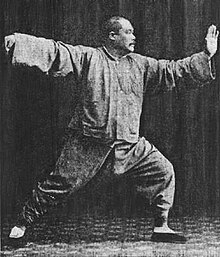Yang Chengfu (1883–1936) was one of the best known teachers of Yang-style tai chi Chinese martial art. He helped develop the art into its modern form. His students would go on to found successful martial arts schools of their own and helped spread Yang-style tai chi around the world.
| Yang Chengfu 杨澄甫 | |
|---|---|
 Yang Chengfu in Single Whip posture of Yang-style tai chi solo form | |
| Born | Yang Zhaoqing (杨兆清) 1883 |
| Died | 1936 (aged 52–53) |
| Style | Yang-style tai chi |
| Notable students | Yang Shouzhong Yang Zhenduo Fu Zhongwen Chen Weiming Dong Yingjie Cheng Man-chʻing Zhang Qinlin Chu Guiting Wang Yongquan (王永泉) |
| Yang Chengfu | |||||||||||||||||||||||
|---|---|---|---|---|---|---|---|---|---|---|---|---|---|---|---|---|---|---|---|---|---|---|---|
| Traditional Chinese | 楊澄甫 | ||||||||||||||||||||||
| Simplified Chinese | 杨澄甫 | ||||||||||||||||||||||
| |||||||||||||||||||||||
Biography
editYang Chengfu was born into the famous Yang family of tai chi practitioners, the son of Yang Jianhou and grandson of Yang Luchan. With his older brother Yang Shaohou and colleagues Wu Jianquan and Sun Lutang, he was among the first teachers to offer tai chi instruction to the general public at the Beijing Physical Culture Research Institute from 1914 until 1928. He moved to Shanghai in 1928.
Chengfu is known for having "smoothed" out the somewhat more vigorous training routine he learned from his family as well as emphasising a "large frame" (大架; dà jià) with expansive movements in stepping and using large circular motions with the arms. His smooth, evenly paced large-frame form, along with its hundreds of offshoots, has been the standard for Yang-style tai chi (and overwhelmingly in the public imagination for tai chi in general) ever since.
Chengfu is the official author of two books on the style, Application Methods of Tai Chi, published in 1931, and Essence and Applications of Tai Chi, published in 1934.[1][2] His second book was translated into English in 2005.[3]
Students and Descendants
editHis direct descendants, the many students he taught, and their students, have spread the art around the world. Among Yang Chengfu's students were famous masters such as Zhao Bin (his older brothers grandson 1906-1906) Dong Yingjie, Chen Weiming, Fu Zhongwen, Li Yaxuan (李雅轩; 1894–1976) and Cheng Man-chʻing. Each of them taught extensively, founding groups that still teach tai chi to this day. Cheng Man-chʻing, perhaps the most famous outside of China, significantly shortened and simplified the traditional forms Yang taught him after his teacher's passing, reportedly to make them more accessible to larger numbers of students. Although Cheng's modifications are considered controversial by most other schools and are not recognized by the Yang family, Cheng Man-chʻing is known as one of the first to teach tai chi in the West.
His sons have continued to teach their father's tai chi, including his first son, the late Yang Shouzhong (1910-1985), who brought Yang-style tai chi to Hong Kong, his second son Yang Zhenji (1921-2007), his third son, Yang Zhenduo (1926-2020), who lived in Shanxi Province, who was widely considered the most prominent of the Yang family tai chi instructors, and his fourth son, Yang Zhenguo, born in 1928, and living in Handan, Hebei.
Bibliography
edit- ^ Yang Chengfu (1931), Taijiquan Shiyongfa (Application methods of Taijiquan)
- ^ Yang Chengfu (1934), Taijiquan Tiyong Quanshu (Complete Book of the Essence and Applications of Taijiquan)
- ^ Yang Chengfu and Louis Swaim, tr. (2005). The Essence and Applications of Taijiquan. North Atlantic Books. ISBN 978-1-55643-545-4.